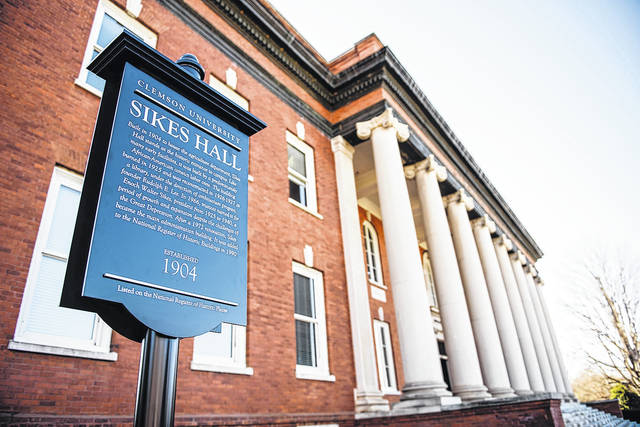CLEMSON — Clemson University has taken another significant step in sharing its complete history with the installation of new signs at each of the 11 historic buildings on the main campus and enhanced markers at Gantt Circle.
The signs are the latest example of the work being done by the university as result of recommendations developed in early 2016 by a history task force commissioned by the university’s board of trustees.
The grounds of each facility on the National Register of Historic Buildings now feature a nine-foot, bronze-colored sign that tells the story of its origin, name and significance to university development.
Also being installed this semester are granite markers to enhance the campus commemoration of the historic enrollment of Harvey B. Gantt, ’65, who was the first African-American to enroll at Clemson. The signage will complement an existing historic marker and recognize action by the board of trustees to officially name the circular drive in front of Tillman Hall “Gantt Circle.” Gantt’s registration took place inside Tillman Hall.
The campus improvements stem from a report adopted in February 2016 outlining recommendations developed by a board task force on the history of Clemson, which was charged with identifying ways to tell the university’s complete history in a way that is “forthcoming, accurate and beneficial to the Clemson family.”
The task force called on the university to erect “more prominent signage of each historical building, including but not limited to the original name of the building and the history relating to its current name“ and “better, more prominent signage for Gantt Circle that provides historical context about Harvey Gantt and why the circle bears his name.”
Pic of Historic signs -2Clemson Vice President and Chief of Staff Max Allen served as administrative liaison for the task force and is leading efforts to implement the board’s recommendations. He said the signs were among the many suggestions that arose from a broad outreach effort to gather input from faculty, staff, students, alumni and friends of the university.
“There is significant interest among our constituents in making sure we tell Clemson’s full history and leave the right kind of legacy for future generations,” he said. “We’re committed to fulfilling the board’s charge.”
Previous work to implement the board’s recommendations include development of a new history website more detailed, candid biographies of founding figures, a revised official timeline that dates back to the Cherokee era and the first “Clemson History in Plain Sight Day.”
Historic markers to designate the location of slave quarters and a stockade for convicts who built the first facilities, the Cherokee village of Esseneca, the Fort Hill plantation, Woodland Cemetery and slave and convict burial grounds have also been done.
Clemson buildings on National Register (main campus) include Fort Hill (National Historic Landmark), Trustee House, Tillman Hall, Hardin Hall, Godfrey Hall, Holtzendorff Hall, Mell Hall, Sikes Hall, Long Hall, Riggs Hall and Sirrine Hall.

